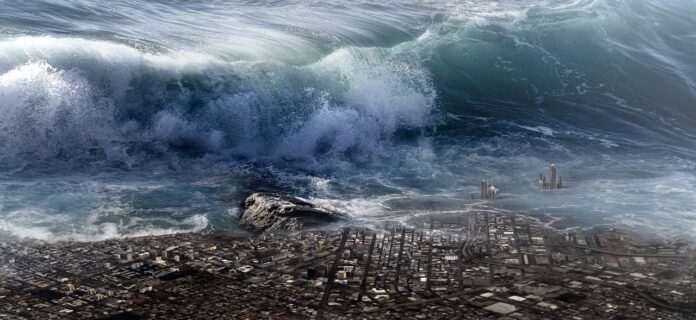Tsunamis are a special type of wave that occurs due to sudden movements of the Earth’s crust. Most often, they occur as a result of earthquakes in the ocean. Initially, the forming wave has a small height, often no more than half a meter. It moves towards the shore at a speed of about 200 m/s. As the water depth decreases, the wave slows down and rises. Its height at the coast can exceed 40 meters.
Narrow bays, which sharply narrow the wave front, are the most dangerous. Closed water bodies with natural breakwaters at their entrances are safer. The most powerful tsunamis are so strong that they can cause damage on different continents. Which tsunamis are considered the most powerful in the world throughout history? Interesting facts about tsunamis.
Tsunami in Indonesia due to the eruption of Krakatoa
The eruption of the volcano began as early as May 20, 1883, and gradually its scale increased. The peak occurred on August 27, when observers recorded a series of explosions estimated at about 100-200 megatons of TNT equivalent.
It is believed that the thunder from the explosions became the loudest sound recorded in human history. As a result, shock waves arose, which generated several destructive tsunamis. Their height exceeded 30 meters. The population of nearby islands, especially Sumatra and Java, suffered the most. More than 36 thousand people died.
Interestingly, scientists still do not fully understand the mechanism of tsunami formation during the eruption of Krakatoa. After all, for example, during an even more powerful eruption of the Tambora volcano in 1815, no high waves were observed.
Tsunami in Lituya Bay
It occurred on July 9, 1958. The bay is located on the coast of Alaska and is a 14-kilometer-long bay, three kilometers wide. The earthquake that occurred that day had a magnitude of about 8.3, which was not record-breaking, but its epicenter was only 21 kilometers from the bay.
As a result, there was a landslide, and about 30 million cubic meters of rock fell into the reservoir. Due to the relief features, a gigantic wave was formed, the height of which reached 524 meters! These figures are not only based on eyewitness accounts but also confirmed by terrain research. Trees damaged by the water flow are located at that height.
This area is sparsely populated, so only 5 people died. Buildings in the nearby town of Yakutat were seriously damaged. When the record wave exited the bay, it significantly weakened and no longer posed a threat.
2011 Tsunami in Japan
On March 11, 2011, an earthquake occurred in the Pacific Ocean, which is one of the five strongest earthquakes in recorded history. It generated a powerful tsunami that hit not only Japan but also other countries.
For example, Russian authorities evacuated 11,000 people from the coast, and there was damage even in Peru and Chile. But Japan suffered the most.
A total of about 16 thousand people died. The water flooded Sendai Airport, waves washed away cars and entire buildings. The Fukushima-1 nuclear power plant, located on the Pacific Ocean coast, was seriously affected. Due to the flooding of backup electricity generators, it was shut down, leading to explosions at three power units.
As a result, a massive release occurred, equivalent to 10% of the release after the Chernobyl disaster. It is less known that serious malfunctions were also observed at three other nuclear power plants: Fukushima-2, Onagawa, and Tokai.
Tsunami after the Valdivia Earthquake
The earthquake that occurred in Chile on May 22, 1960, is considered the most powerful in the world in recorded history. Its epicenter was on the mainland, near the city of Valdivia, but nevertheless, an extremely powerful tsunami occurred.
A wave about 10 meters high crashed onto the Chilean coast and washed away several dozen settlements. About 6000 people died in total. The wave was so powerful that some houses were carried three kilometers inland.
After hitting South America, the tsunami turned back. It reached the coast of Japan, where it caused the deaths of another 150 people. More than 6,000 structures were destroyed in Japan. High waves were also recorded in Hawaii and along the coast of California.
2004 Indian Ocean Mega-Tsunami
This wave is considered the most powerful and destructive in history. It occurred after an earthquake, the epicenter of which was near the island of Sumatra. It is believed that this earthquake was the second most powerful in recorded history, with a magnitude of 9.3.
The fault itself, 1200 kilometers long, created in the Earth’s crust, was directed from south to north, so the waves traveling perpendicular to it, to the east and west, had the greatest energy. Therefore, Bangladesh hardly suffered, although this country is very close to the earthquake epicenter, but in Somalia, the damage was much more significant.
The wave traveled at a speed of about 800-1000 km/h, so in Africa, people knew about the impending danger several hours before the tsunami hit the continent. Interestingly, even in Mexico, waves as high as 2.6 meters were recorded in some places.
The total number of deaths is estimated at 235 thousand people. The wave was able to reach settlements located 4 kilometers from the coast. In Sri Lanka, the tsunami washed away an entire train carrying about 2000 passengers. Only 150 people survived. This was the largest railway disaster in history.
